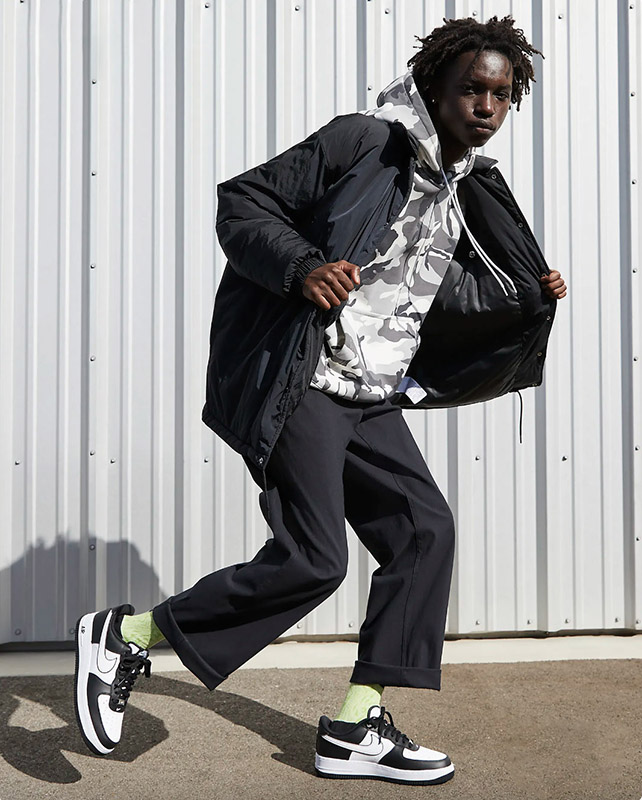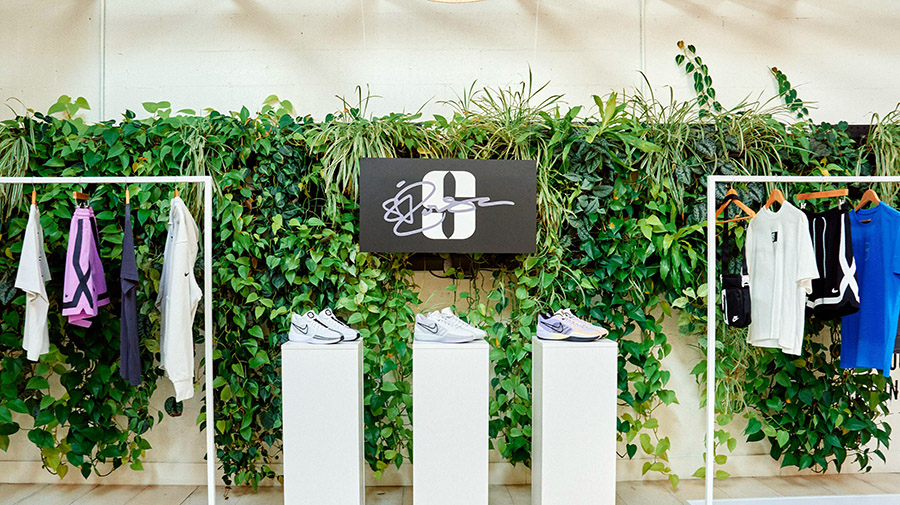Shares of Nike, Inc. were forecasted to open down about 15 percent on Friday morning, June 28, after the company revised its forecast for sales to be down mid-single digits for its fiscal year ended May 31, 2025, including a high-single-digit drop in the first half. NKE shares, a Dow 30 component, closed down 20 percent for the day on Friday – and down approximately 33 percent for the year – helping trim 45 points off the Dow 30 Index for the day.
Nike executives told analysts that promising innovations would not scale quickly enough to offset sluggish sales of its largest franchises, including Air Force 1, Air Jordan 1 and Dunk.
On its fiscal Q324 call in mid-March, Nike had forecasted sales would increase for the year with a low-single-digit decline in the first half.
On its fiscal fourth-quarter conference call Thursday evening, June 27, CFO Matthew Friend said the brand had been “navigating several headwinds” in its fourth quarter that it now expects will have “a more pronounced impact” on FY25.
The first headwind is its lifestyle footwear business, which saw a decline across Nike men’s, Nike women’s and Jordan in the fiscal fourth quarter after generating double-digit growth over the past several years.
John Donahoe, Nike’s president and CEO, on the analyst call noted that while Nike has witnessed a strong response in its introduction of Dynamic Air and the return of retro Y2K styles in its lifestyle offerings, the brand will be accelerating planned reductions of its three largest franchises that fall in the lifestyle category in the coming quarters due to softening demand. Donahoe said, “This will have a meaningful impact near-term on our overall lifestyle growth rate.”
The second related headwind was digital, where sales declined 10 percent in the fourth quarter, missing plan, due to higher promotions and lower sales of certain classic footwear franchises. Friend said, “More specifically, these franchises underperformed the overall digital business results in the quarter, especially in April and May, and continuing into early June; this is even as these franchises continue to drive retail sales growth at high full price realization in multi-brand retail.”
Friend noted that the franchises have “their highest share of business” on Nike Digital. Nike has shifted to reestablishing its presence across wholesale accounts to rebalance distribution and revive demand. The expected lower digital growth projected for FY25 also reflects lower traffic on fewer launches, particularly in the first half.
A third factor in the sales forecast revision is macro-economic pressures overseas, notably softer growth in China, where brick-and-mortar traffic declined as much as double-digits in the fourth quarter. The EMEA region has also seen “uneven” trends, said Friend.
Finally, the lower sales guidance reflects reduced promotional activity and a worsening impact on foreign exchange.

First Quarter Sales Expected to Decline 10 Percent
For the current fiscal first quarter, Nike expects sales to decline approximately 10 percent, reflecting “more aggressive actions in managing our classic footwear franchises, continuing challenges on Nike Digital, muted wholesale order books with newness not yet at scale, a softer outlook in greater China, and a number of quarter-specific timing factors,” said Friend.
The timing issues include TMall’s earlier start to the 6/18 shopping holiday that benefited fourth-quarter results at the expense of the first quarter, as well as some favorable shipment timing in North America in the fourth quarter as Nike prepares to go live with a new ERP (Enterprise Resource Planning) platform and due to improved inventory availability.
On the positive side, Friend said Nike expects to see “meaningful sequential improvement” in the second half of FY25, reflecting Nike’s confidence in its ability to scale much of the new products coming to market, including the Peg 41, Peg Premium, Vomero 18, Air Max DN and the next Air Max iteration.
“We are managing a product cycle transition with complexity amplified by shifting channel mix dynamics,” said Friend. “A comeback at this scale takes time.”
Q4 EPS Tops Estimates, Sales Fall Just Short
In the fiscal fourth quarter ended May 31, sales slid 1.7 percent to $12.6 billion, slightly off from Wall Street’s consensus target of $1.49 billion. Sales were flat on a currency-neutral basis. Among channels, sales dropped 7 percent at Nike Direct, with declines of 10 percent at Nike Digital and 2 percent at Nike Stores. Wholesale grew 8 percent.
Gross margins expanded 110 basis points to 44.7 percent on a reported basis, primarily due to strategic pricing actions, lower ocean freight rates and improved supply chain efficiency, partially offset by lower margins in Nike Direct, an unfavorable channel mix and net foreign exchange impact.
SG&A was down 7 percent on a reported basis as increased investment in marketing was more than offset by reductions in operational overhead.
Last December, Nike announced plans to lay off 2 percent of its workforce over the next three years as part of cost-containment efforts. The quarter included approximately $40 million in restructuring charges. As a percent of sales, SG&A was reduced to 32.4 percent from 34.1 percent a year ago.
Earnings rose 45.5 percent to $1.5 billion, or 99 cents a share, from $103 billion, or 67 cents, a year ago. Results topped analysts’ consensus estimate of 84 cents due to the margin improvement.
For the full year, revenue was flat on a reported basis, reaching $51.4 billion, and gained 1 percent on a currency-neutral basis. Net earnings rose 12.4 percent to $5.7 billion, or $3.73 a share.
Inventory at the close of the year declined 11 percent versus the prior year, with continued improvement in days in inventory.
North America is the Only Region to Show a Decline
By region, revenues in North America declined 1 percent on a currency-neutral basis (1.4 percent reported) to $5.3 billion. Nike Direct was down 9 percent, with Nike Digital off 11 percent and Nike stores down 5 percent. Wholesale grew 6 percent due to accelerated shipping timing from Q125. EBIT grew 5 percent on a reported basis. Softer traffic was seen at Nike’s factory stores, “highlighting increasing pressure being felt by the value consumer,” said Friend. Declines in lifestyle and Jordan offset strong growth in basketball, fitness and kids. Kids led Nike’s results in North America with performance up strong double-digits. Nike gained market share in women’s fitness footwear. In men’s and women’s running in North America, fall footwear bookings are up double-digits, led by the Pegasus 41.
In the EMEA, Q4 revenue grew 1 percent on a currency-neutral basis (down 1.7 percent reported) to $3.29 billion. Nike Direct was down 8 percent as Nike stores grew 1 percent and Nike Digital declined 14 percent. Wholesale grew 7 percent. EBIT grew 2 percent on a reported basis. Friend said, “In a cautious macro environment, we are seeing performance innovation drive strong sell-through. This is partially offset by overall declines in lifestyle, with new product releases working well.”
Global football grew double-digits across men’s and kids. In women’s fitness, strong momentum was seen in footwear and new apparel releases, including the Refresh Nike Pro. In lifestyle, retro-running franchises continue to scale, and Air Max DM saw a healthy launch.
In Greater China, Q4 revenue grew 7 percent on a currency-neutral basis (2.9 percent reported) to $1.86 billion. Excluding TMall’s earlier start to the 6/18 shopping holiday, China’s sales missed plan, with traffic softness persisting across all marketplace channels. Nike Direct declined 2 percent, with Nike stores down 6 percent and Nike Digital up 8 percent. Wholesale grew 15 percent. EBIT increased 4 percent on a reported basis with continued impacts from foreign exchange. On the positive side, kids led the gains in China, led by running and basketball. Within men’s and women’s lifestyle, retro running styles drove positive consumer response. In men’s and women’s running, Structure, Vomero, and Invincible grew double-digits at retail.
Friend said, “The China marketplace remains highly promotional, and we continue to manage both Nike and partner inventory carefully. While our outlook for the near term has softened, we remain confident in Nike’s competitive position in China in the long term.”
In the APLA region, Q4 revenue grew 4 percent (0.5 percent reported) to $1.71 billion. Nike Direct declined 3 percent, with Nike stores up 11 percent and Nike Digital down 12 percent. Wholesale grew 9 percent, and EBIT advanced 4 percent on a reported basis. Mexico, Southeast Asia and India led the growth. Among categories, men’s basketball, men’s global football and women’s fitness were up double-digits.

Nike’s CEO Sees FY25 As “Transition Year”
In his scripted comments, Donahoe said 2025 “will be a transition year” for Nike as the company has made several leadership and organizational changes and has undergone extensive restructuring to create the capacity to reinvest in innovation and consumer-facing activities.
“We’re making a series of adjustments to position us to compete and win,” said Donahoe. “We’re sharpening our focus on sport, accelerating our pace and scaling of newness and innovation, driving bigger, bolder storytelling, [and] elevating the entire marketplace to fuel brand distinction and be in the path of the consumer. This is our playbook, and we’re seeing momentum build in all four areas.”
Donahoe called out Nike’s progress in performance product, which grew double-digits in the fourth quarter. In performance, basketball saw double-digit growth across men’s, women’s, kids, and Jordan, driven by innovation within its G.T. Cut franchise, Kobe’s new footwear and apparel range and the success of Sabrina Ionescu’s inaugural shoe. The Sabrina 1 has taken 2 points of share across the entire U.S. basketball market, including both men’s and women’s.
Nike is launching the Sabrina 2 in July, has set plans to launch A’ja Wilson’s first shoe in 2025, and signed Caitlin Clark as an ambassador to further “fuel the rapid growth of our women’s basketball business” amid record WNBA ratings, said Donahoe. On the men’s side, “one of the Jordan Brand’s biggest marketing efforts ever” recently occurred as two of the brand’s athletes, Jason Tatum and Luca Doncic, squared off at the NBA Finals.
Nike’s fitness business, which is particularly important in reaching women, was led by double-digit growth in apparel. Leggings surged high-single-digits in the fourth quarter with a strong response to the introduction of Universa, Zenvy, and Go franchises. Women’s fitness footwear had a strong quarter, driven by Motiva and the latest version of Free Metcon.
Road running was impacted in the fourth quarter by planning reductions in Nike’s Pegasus range, but new releases in Vomero, Invincible, Infinity and Structure all grew by high-double-digits over the fourth quarter. Said Donahoe, “We’re making it easier for consumers to discover these styles by simplifying our running construct at retail as we highlight our best-in-class cushioning technologies.”
The Pegasus 41, launched a few weeks ago, saw better than expected sell-through in wholesale and Nike Direct channels, helped by a broad marketing push, including investing in run specialty doors. Pegasus Premium and Vomero 18 will arrive in the second half of FY25, helping support strong double-digit growth in order books with North American running specialty partners in both holiday 2024 and spring 2025.
In lifestyle, fresh releases have positively resonated with consumers, including new executions around retro running and field franchises, including the Cortez, Killshot and the Field General. Donahoe also noted that the Air Max DN, launched at the start of 2024, has become a Top 10 lifestyle franchise in men’s, tapping urban sneakerheads. Nike has planned the next two iterations of Dynamic Air to build on its cushioning platform’s promising introduction this past spring.
Friend also noted that a refreshed lineup of new footwear products below $100 delivered double-digit growth in the fourth quarter with plans to scale new below-$100 performance and lifestyle models in spring 2025. Said Friend, “We expect the business contribution from new products to more than double from the start of fiscal 2024 to where we end the year in fiscal 2025.”
Friend also noted that the company is focused on managing expenses, including reducing small parcel fulfillment costs, consolidating suppliers, optimizing technology spend, and restructuring its staff to streamline layers and support functions as part of a “Save To Invest” initiative. Nike will use the cost savings to “reinvest nearly $1 billion in consumer-facing activities in fiscal 2025, which we expect to accelerate our return to strong growth.” The investments include establishing the running category in key cities, increasing resources in design, product creation, and merchandising for key sports, “elevating the distinction of our brand in physical retail,” and “driving bigger, bolder” brand campaigns.
Friend also noted that Nike had tapped success in the past by similarly “proactively rebalancing our portfolio” to refuel brand momentum.
In fiscal 2018, Nike recalibrated its inventory of select Jordan brand franchises and helped shift double-digit declines into “multiple consecutive years of strong double-digit growth.” Earlier this year, growth in Nike’s lifestyle footwear portfolio in Japan and Korea was revitalized as supplies of some classic franchises were reduced in the marketplace and other models scaled.
Friend said, “Although the next few quarters will be challenging, we are confident that we are repositioning Nike to be more competitive, with a more balanced portfolio, to drive sustainable, profitable long-term growth.”
Images courtesy Nike















